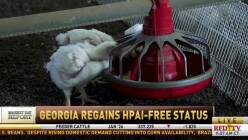Southeast
The latest agricultural news related to Alabama, Florida, Georgia, Kentucky, Louisiana, North Carolina, Tennessee, and other states in the Southeastern United States.
Tim and Sharyn Abbott of the Music City Celebration Sale recap the weekend’s premier auction, which drew top dairy breeders and buyers to Nashville again this year from across North America.
Southern producers head into 2026 with thin margins, tighter credit, and rising agronomic risks despite scattered yield improvements.
Water access—not acreage alone—is driving where irrigation expands or contracts.
Raulston Acres Christmas Tree Farm in Rock Springs, Ga., has been in the same family for three generations.
Rooster is a full-time farmhand, right-hand man on Shawn Raff’s cattle and dairy operation in Eatonton, Georgia.
Strong demand supports sweet potatoes, but grading challenges and rising costs weigh on returns for Southeastern growers.
The Cotton-4 are pushing hard for new value chain investments. Still, many U.S. cotton producers face unsustainable losses, and weakened regional textile capacity threatens the survival of the Carolina “dirt-to-shirt” supply chain.
The newly elected Executive Vice President of the Tennessee Cattlemen’s Association (TCA), Dale Parker, joins us on-set to share his vision for his state’s cattle industry.
Pasture, Rangeland and Forage (PRF) interval selection—not just participation—drives protection levels as rainfall patterns become less predictable across the South.
It started as a simple service project for 4-H — collect some shoes, help a few people. But for Franklin Parish High School senior Eli Rogers, it has turned into something much bigger.
First-Ever ‘MICHELIN Guide to the American South’ Celebrates Region as a Global Culinary Destination
The first-ever “MICHELIN Guide to the American South” awards stars to top restaurants across Georgia, Louisiana, the Carolinas, and Tennessee, and pinpoints the region as a global food destination for the first time.
A strong corn export pull is supportive of bids; soybeans need steady vessel programs or fresh sales to firm cash.
Persistently low Mississippi River levels are turning logistics challenges into pricing risks — tightening margins for grain producers and exporters across the heartland.
Margin Protection and the new MCO add county-level margin tools — with earlier price discovery, input cost triggers, and high subsidy rates — to complement on-farm risk plans for 2026.
Bubba and Amy Miller run Miller Cattle Company in Eros, Louisiana. After visiting other homesteading fairs, they decided to put on their own.
Southern farms are deepening online engagement for cost savings and market access, while higher-cost precision technologies face renewed scrutiny amid tight budgets.
The Louisiana cotton crop is the smallest on record, but strong yields are a silver lining. LSU AgCenter’s Craig Gautreaux reports from northeast Louisiana.
Tammi Arender takes us to 3 Board Farm to meet some first-generation farmers who took a leap of faith and, in the process, found a new purpose.
From finding her community in FFA to leading as a State President, Caroline has an inspiring story!
Bright Star Ranch continues to offer hope, connection, and healing through its equine therapy programs.
Hop in the cab with RFD-TV’s Tammi Arrender as she embarks goes Rural Road Trippin’ to Farmerville, Louisiana, for the Bayou for the Bayou D’Arbonne Folk Life Festival.
























